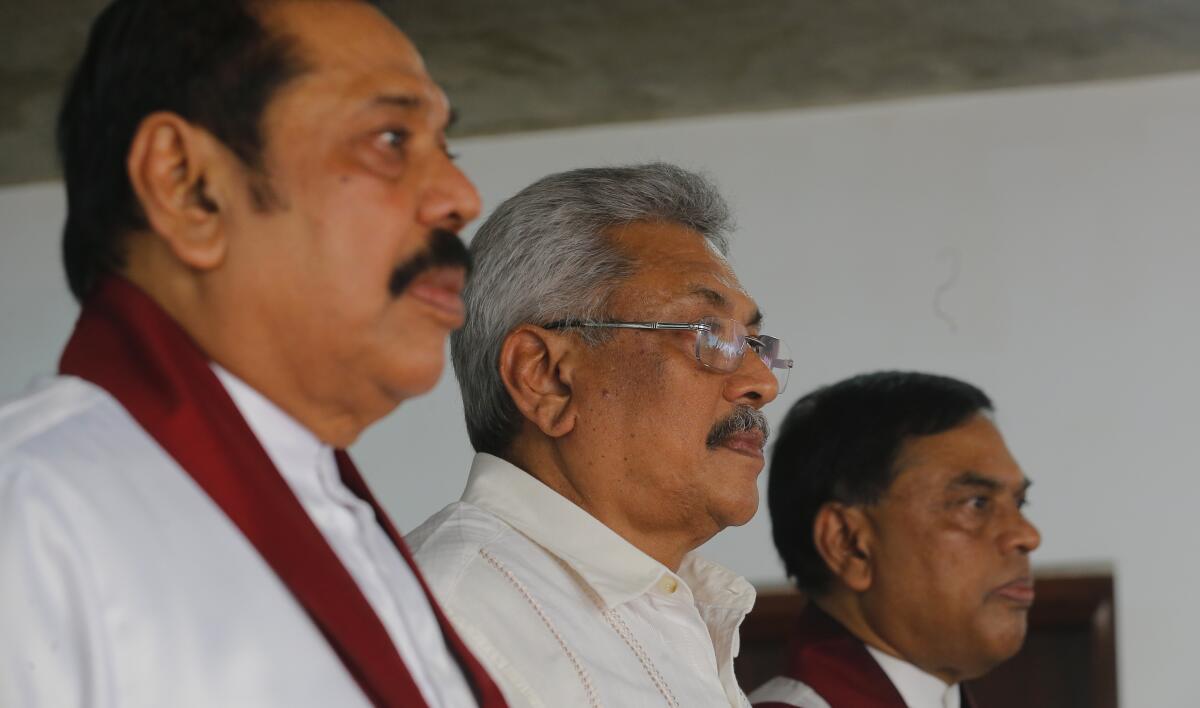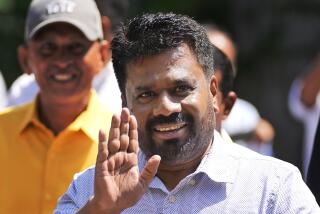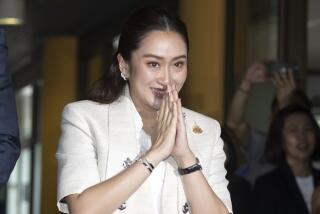Sri Lankan power family falls from grace as economy tanks

- Share via
NEW DELHI — With one brother serving as president, another as prime minister and three more relatives as Cabinet ministers, it appeared that the Rajapaksa clan had consolidated its grip on power in Sri Lanka after decades in and out of government.
But as a national debt crisis spirals out of control — with pandemic woes and rising food and fuel costs as the war in Ukraine compounds problems from years of dubious economic decisions — their dynasty is crumbling.
The three Rajapaksas resigned from their Cabinet posts in April, Prime Minister Mahinda Rajapaksa stepped down Monday, and President Gotabaya Rajapaksa has not been seen recently outside his heavily guarded compound. Angry protesters attacked the family’s home this week.
But the family continues to fight to keep its hold on power, ordering troops to shoot protesters who cause injury to people or property, instituting a nationwide curfew and allegedly encouraging mobs of supporters to fight in the streets against antigovernment demonstrators.
In his first speech to the nation in two months, President Rajapaksa on Wednesday said he would return more power to Parliament by rolling back an amendment he implemented to buttress the all-powerful executive presidential system. On Thursday he appointed a new prime minister, who is not a relative.
But it might be too late to put an end to the protests calling for the ouster of the president, the last Rajapaksa clinging to national office.
“This is a crisis very much of his making,” said Paikiasothy Saravanamuttu, executive director of the Center for Policy Alternatives think tank in the capital, Colombo. “He did not create the crisis from the beginning, but the Rajapaksas have come to epitomize the failings in our structure of government with their nepotism, their corruption and their human rights violations.”
Facing soaring prices, shortages and lengthy power cuts, Sri Lankans have been protesting for weeks, calling for the Rajapaksas to step down. Violence erupted Monday after Rajapaksa supporters clashed with protesters, leading to nine people being killed and more than 200 injured and, in a dramatic turn, Mahinda’s resignation.
Angry protesters attacked the family’s ancestral home in the Hambantota area, and Mahinda has taken refuge at a heavily fortified naval base.
With his atypically conciliatory speech Wednesday, it is clear that Gotabaya Rajapaksa has been “badly shaken by the protests,” according to Dayan Jayatilleka, a former diplomat who served as Sri Lanka’s representative to the United Nations when Mahinda was president. Still, it may be too early to count him out, Jayatilleka said, noting that Gotabaya had changed his tone to sound “flexible and pragmatic.”
“Gotabaya has a dualistic personality; one side of that personality that the country has seen is this unilateralist, quite insensitive, ex-military man,” Jayatilleka said. “But there’s another side — somewhat more rational. But the more rational side was on a very long vacation.”
The Rajapaksa family has been involved in Sri Lankan politics for decades, with the focus most recently on Mahinda, the president’s older brother.
While Gotabaya pursued a military career and rose through the ranks, Mahinda focused on politics and was elected president in 2005. Gotabaya, who by then had retired from the military and immigrated to the United States, returned to become defense secretary.
The two won enormous support among their fellow Sinhalese Buddhists for ending the country’s 26-year civil war with ethnic Tamil rebels in 2009. Mahinda was reelected in 2010.
About 70% of Sri Lanka’s 22 million people are Buddhists, mainly ethnic Sinhalese. Hindus, mainly ethnic Tamils, make up 12.6% of the population; Muslims, 9.7%; and Christians, 7.6%.
Minority groups and international observers have accused the military of targeting civilians in the war and killing rebels and civilians who surrendered in the final days. According to a U.N. report, about 40,000 Tamil civilians were killed in the final months of fighting.
Mahinda pushed through a constitutional change to allow him to run for a third presidential term and called for elections early in 2015 to press what he saw
as an advantage, but he was defeated in an upset by Maithripala Sirisena, who garnered support from minorities with his reformist platform and push for reconciliation.
Mahinda then sought unsuccessfully to become prime minister. It appeared that the luster of the Rajapaksa name had worn off.
But with Sirisena’s coalition government already plagued with infighting and dysfunction, Islamic extremists on Easter 2019 targeted Christian churches and luxury hotels in coordinated suicide attacks, killing hundreds of people.
Amid a wave of Buddhist nationalism and allegations that the Sirisena government had not acted on intelligence information, Gotabaya Rajapaksa swept to power in a landslide later that year.
“The bombs catapulted him to victory in the 2019 election,” Jayatilleka said. “The feeling was we need Gotabaya, we need his military experience.”
Gotabaya appointed Mahinda as prime minister and added two other brothers and a nephew to his Cabinet. In 2020, he pushed through a constitutional amendment strengthening the power of his office, at the expense of Parliament.
By the time Gotabaya took office, Sri Lanka was in an economic slump triggered by a drop in tourism after the bombings and a slew of foreign debt from
infrastructure projects, many bankrolled by Chinese money and commissioned by Mahinda.
In one notorious case, Mahinda borrowed deeply from China to build a port in Hambantota, the family’s home region. Unable to make its debt payments on the project, Sri Lanka was forced to hand the facility and thousands of acres of land around it to Beijing for 99 years — giving China a key foothold opposite the coastline of India, a regional rival.
With the economy already teetering, Gotabaya pushed through the largest tax cuts in Sri Lankan history, a move that sparked a quick backlash, with creditors downgrading the country’s ratings and blocking
it from borrowing more money as foreign exchange reserves nosedived.
The pandemic hit soon after, again battering tourism, a prime source of foreign currency. In April 2021, a poorly executed ban on importing chemical fertilizers made matters worse by driving up prices; Gotabaya was forced to repeal the law.
Compounding problems this year, the war in Ukraine has increased food and oil prices globally. The central bank said inflation was at 30% in April, with food prices up nearly 50%.
With the economy in tatters, protests have come from all sectors of society; even Sinhalese Buddhists are joining in.
“There is public vilification of the Rajapaksas now, and that’s a notable change to what we were seeing previously,” said Bhavani Fonseka, a senior researcher at the Center for Policy Alternatives. There is a “genuine anger among the people that it’s the Rajapaksas who have led to this crisis,” she said.
Still, Jayatilleka suggested that if Gotabaya can appoint a new Cabinet that enjoys popular support, he may be able to cling to office.
“If he stitches together a government that looks somewhat new — not as top-heavy with the Rajapaksas, as it was stuffed full of them — that may have more success,” he said.
But Saravanamuttu said it was too late for a comeback.
“His constituency has turned against him, and therefore he has no real power base left in the country,” he said. “Word from the street is that he has to go.”
Rising reported from Bangkok and Pathi from New Delhi.
More to Read
Sign up for Essential California
The most important California stories and recommendations in your inbox every morning.
You may occasionally receive promotional content from the Los Angeles Times.










